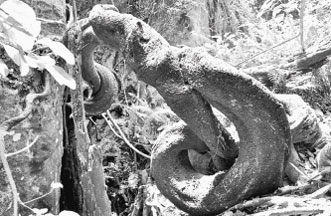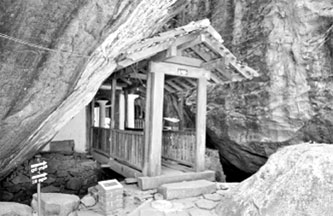|
Pilikuththuwa Raja Maha Vihara:
Cave temple steeped in legend
By Nivanthi THILAKARATNE
In the distant past caves were natural shelters that protected man
from the rain and sun. They were also natural fortresses which protected
him from wild beasts and cannibals. What is more caves were used by
bhikkhus and hermits for meditation.
History tells us that prehistoric man lived in caves. Cave paintings
in Altamira in Spain, Bhimbetka in India and Pech Merle in France
substantiate this point.
 In Sri Lanka too there were prehistoric caves at Belilena in
Kitulgala, Wavulpane in Ratnapura, Fa Hien cave in Kalutara, Bellanbandi
Palassa in Balangoda and Dorawaka Lena in Kegalle. Stone tools and bones
of animals used by prehistoric man have been found in one of the caves
in Pilikuththuwa. Archaeological officer K.A.I. Kuruppu says there had
been a Raja Maha Vihara in Pilikuththuwa. In Sri Lanka too there were prehistoric caves at Belilena in
Kitulgala, Wavulpane in Ratnapura, Fa Hien cave in Kalutara, Bellanbandi
Palassa in Balangoda and Dorawaka Lena in Kegalle. Stone tools and bones
of animals used by prehistoric man have been found in one of the caves
in Pilikuththuwa. Archaeological officer K.A.I. Kuruppu says there had
been a Raja Maha Vihara in Pilikuththuwa.
Today Pilikuththuwa Raja Maha Vihara is a cave temple at
Pilikuththuwa in the Gampaha district.
There are two main routes to reach the vihara. If you come along the
Colombo – Kandy highway you will have to turn to Wathurugama road at
Miriswatta junction. After five kilometres you can reach the
Pilikuththuwa junction. The vihara is five hundred metres away. One who
comes along the Kandy – Colombo highway, should turn to Kirindiwela main
road at Yakkala junction. After passing the Batagolla and Jambolagas
junctions one can reach Wathurugama road.
Legends
There are some legends regarding the formation of the name ‘Pilikuththuwa’.
In the past there had been five divisions called ‘Kotuwas’ namely Pili
Kotuwa, Arachchi Kotuwa, Mal Kotuwa, Halpath Kotuwa and Biligaha Kotuwa.
As the years rolled on, the five Kotuwas had been amalgamated into a
single village known as Pilikotuwa. Thereafter Pilikotuwa had changed
its name as Pilikuththuwa.
According to another legend the village had supplied clothes to the
king. Therefore, the village had been named as Pilikuththuwa because
‘Pili’ in Sinhala means clothes. There is another legend connected to
Soma Devi, queen of King Valagamba.
The royal clothes of the queen had been hidden in a cave of this
place.
Therefore, the village had been named as Pilikuththuwa.
Pilikuthtuwa is a wonderful creation of nature with jungle and huge
rocks. And it is also a cave complex spreading over an area about 200
acres.
It includes 99 carved drip-ledged caves and 78 caves out of them have
been identified by the Department of Archaeology.
We reached several caves along a narrow path passing huge trees and
creepers.
Once we had to climb rocks and another time we had to go through
bushes. We were able to see a giant Puswela which was one of significant
features of the place.
The Puswela which has been spread in a huge area is evidence to prove
the importance of the place. It is believed that the Puswela is at least
500 years old. The root of Puswela was difficult to find because of the
rock formation.
Several Brahmi inscriptions have been found in the cave complex. The
main inscription says Aggibhuti who was a provincial ruler donated it to
the Sangha. There is a reference to ‘manorame’ in the second
inscription.

The 500 -year- old Puswela |

The entrance to the Cave temple |
The third inscription has a reference to ‘Dakina Lena’. Although
another inscription has been found by the Archaeological Department, it
has not been identified yet.
History
According to archaeological officer, K.A.I. Kuruppu, history of the
place goes back to three eras. It was a sacred place in the Anuradhapura
era because of Brahmi inscription. Also it is believed that king
Valagamba had used it as a hideout.
The highest point of the place is called ‘Belumgala’ and it is said
that King Valagamba had used it to observe the surrounding area.
It is believed that the front portion of the vihara and cave
hermitages had been built during the time of Induruwe Sonuttara thera in
the Kotte era. Some people believe that the vihara had been built by
Paranatala Sonuttara thera who was one of the students of Weliwita Sri
Saranankara Thera.
A shrine room has been built in one of the caves. The murals depict
Dharmapala, Maha Kanha and Wessanthara Jathaka stories. Doratupala
(doormen) figures are important because they had been drawn as
Portuguese soldiers with swords.
Also there can be seen rare murals of bhikkhunis near the statue of
the Buddha.
The front site of the ceiling had been painted with astrological
signs.
The canopy of the shrine room has been decorated with thousands of
lotus flowers. It is believed that the murals of the shrine room had
been painted by Mangala Thiriye Siriya.
Treasure hunters have destroyed part of the stupa. Dharmasalawa of
the vihara is a significant architectural creation. Soft granite has
been used for the floor.
A Dolawa (palanquin) found in the place has been repaired by the
Department of Archaeology. Hikkaduwe Sri Sumangala Thera was believed to
have used it.
The wooden bridge which connects two cave hermitages is a unique
feature of the vihara.
In addition a Vishnu Devala and an ancient pond enhance the value of
the vihara. |

